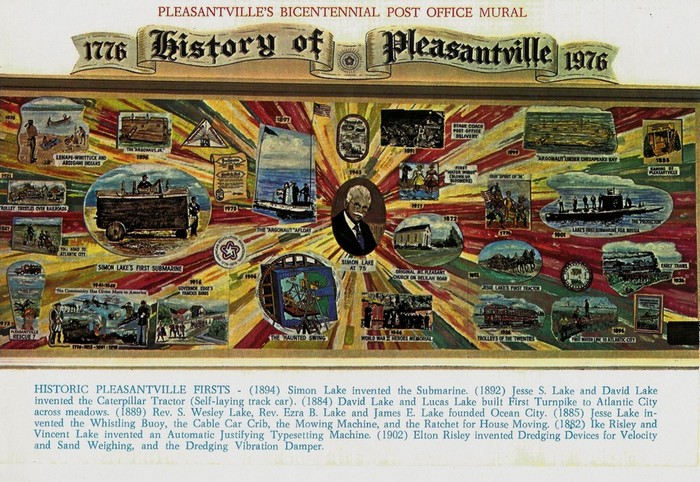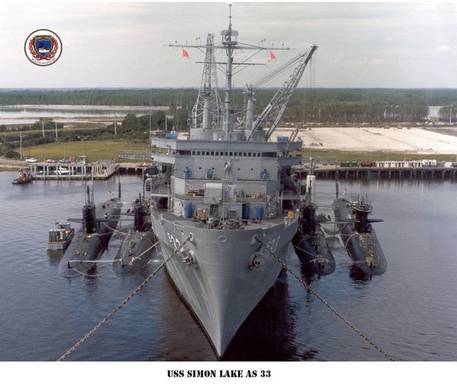Simon Lake (1866-1945) was born in Pleasantville, New Jersey.
Simon Lake (1866-1945) was born in Pleasantville, New Jersey.

He was a God fearing and patriotic American who came from a family of inventors. Simon Lake had several hundred patents awarded him over his lifetime, but he is primarily known as the inventor of the modern, even-keel submarine whose designs and patented methods are in use to this day. The USS Simon Lake AS33 Naval tender-ship was named in his honor.

Simon Lake brought neutral buoyancy to submarines, making em manageable underwater. He also invented the compressed air diving chamber that would allow an open hatch under the water of a submerged vessel. From this he made the first underwater movie, telephone call and walked the ocean floor. He loved moving about under the water and did much salvaging and treasure hunting. He also invented the Omni-scope, the first periscope.
Many inventors at those times knew each other. Simon Lake had the same manager and attorneys as the Wright Brothers: Charles Flint, and Hart O'Berg. The Lake family has a vast archive of hundred year old newspaper clippings, patents, foreign contracts, photographs, blueprints and the like. In the collection we have film reels, including footage of Amelia Earhart on his submarine in promotional events. (Some of the collection is at the Submarine Force Museum in Groton, CT as well.)
Although a man named Holland was the first contracted builder for the US Navy, Simon Lake built the first working, fully maneuverable underwater submarine in 1894 named the Argonaut Jr. He is to the water what the Wright Brothers were to the air. He mastered it. There were others who developed submersible devices before him, like there had been air balloons and such before the Wright Brothers. But each had learned to take control of and master the forces thereof with their innovations. This propelled each field into new eras of sophistication and advancement.
In 1893, four out of five US Naval Admirals approved Lake's plans for the first US submarine; but he didn't submit a bid. The admirals wanted to bring him in to write one up and proceed, but this was not to be. The other submarine plan by Holland was built as his competitor''s financial backer had considerable congressional influence. (JP Holland, pages 94, 120, by Morris, Readers Digest- March, 1943) Not to be deterred, Simon Lake built a small submarine himself, the Argonaut Jr. in 1894. He was out and about for years while Holland's 1896 Plunger never worked properly and was abandoned. It was years before his competitor J.P. Holland’s first successful dockside trial of his ˜porpoising™ Holland VI submarine, which was bought by the US Navy in 1900. This type of positive buoyancy submarine would soon be dropped by all world navies in favor of the Lake type design.
In 1897, Jules Verne of 20,000 Leagues Under the Sea publicly sent Simon Lake a telegram congratulating him on his success. He and his five men made an arduous underwater trip for hundreds of miles off the New England coast during a North-Easter that sunk over 200 ships. The world acknowledged his accomplishments, but his government would not.
In 1903 Secretary of War and future president Howard Taft tried to build several Lake submarines for coastal defense, congress again said “no†to appropriations. This was ten years prior to WWI. Lake then tried to build for England, but he was locked out by political maneuvering as in the USA. In 1904 he sold his very successful US built Protector submarine to Russia for their war with Japan. While there, he competed in and won grueling sea trials against his United States and European competitors. He was given contracts to build for Russia, Austria and others, the Germans using his designs as the base for their U-boats. (The Story of Submarines, by George Weller, Random House, 1962; Submarines at War: The History of America™s Silent Service, Edwin P. Hoyt, Stein and Day, 1983)
After building many working submarines for other countries, Simon Lake was finally asked to return to the states and build for the US Navy under strict requirements. He passed these and broke deep water dive records. He went on to build submarines for the US Navy prior to, and during WWI. He spent his final years on undersea expeditions and searching for sunken treasure.
Simon Lake died a beloved and honorable man who made some of the most important historical contributions to navies around the world. (An article about Simon Lake's life and work from YANKEE magazine is attached to this page.)
Thank you to Jeff Lake of the Simon Lake Project, Grant, FL., and the U.S. Submarine Force Library and Museum, Groton, CT.
